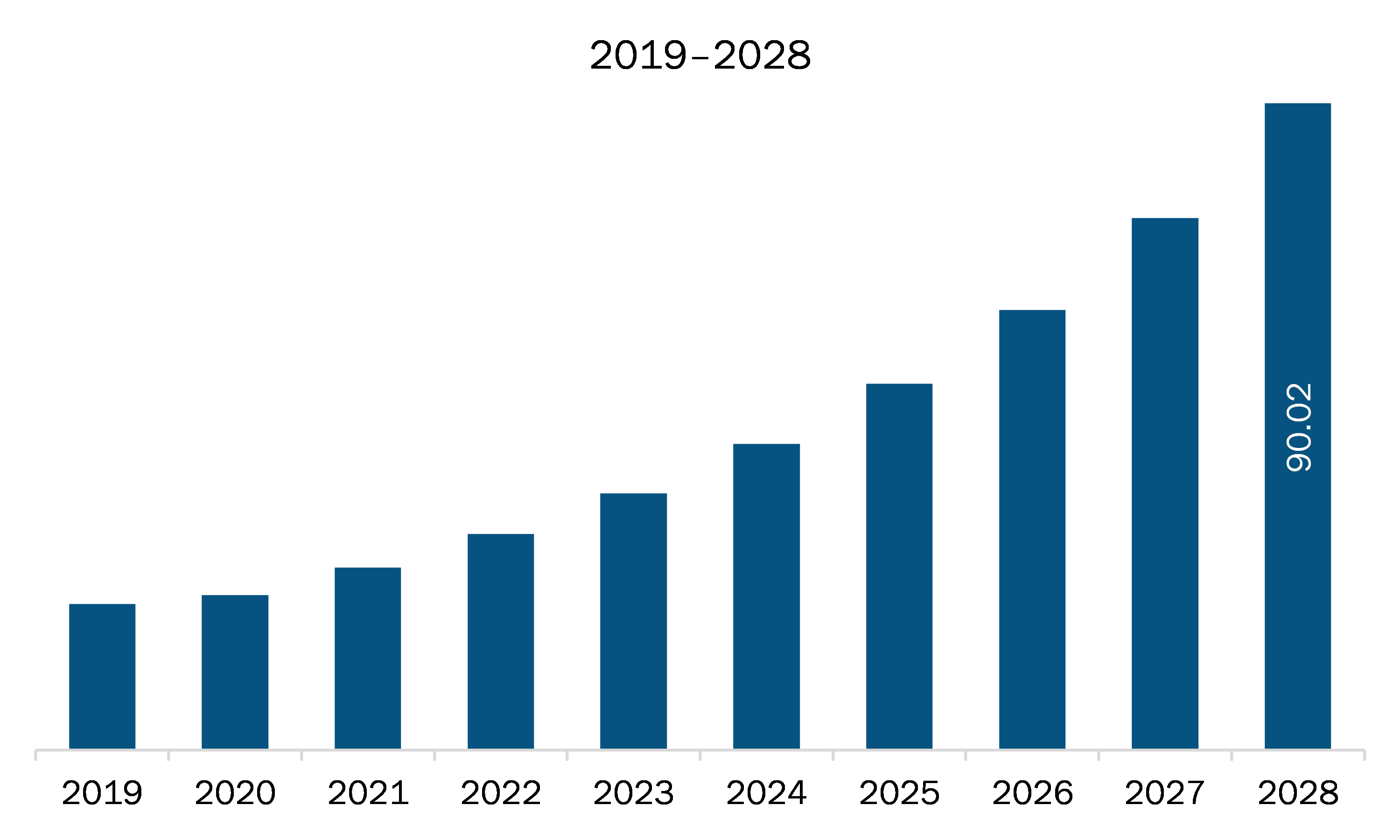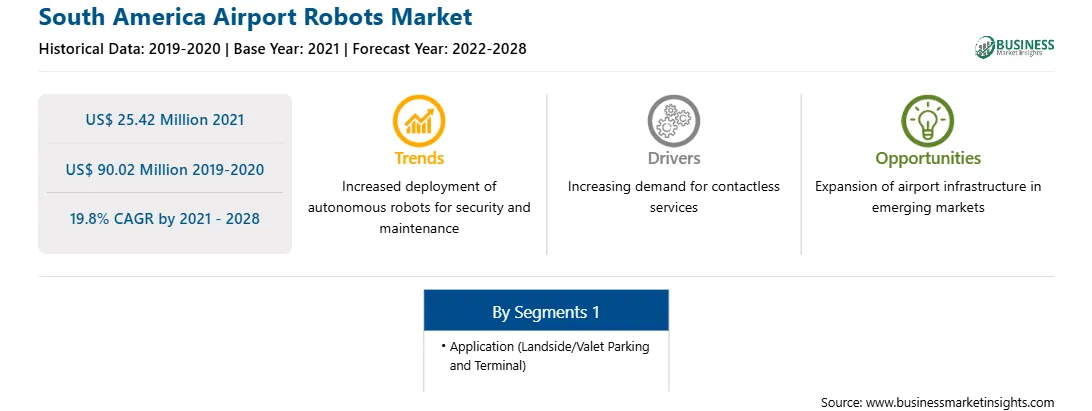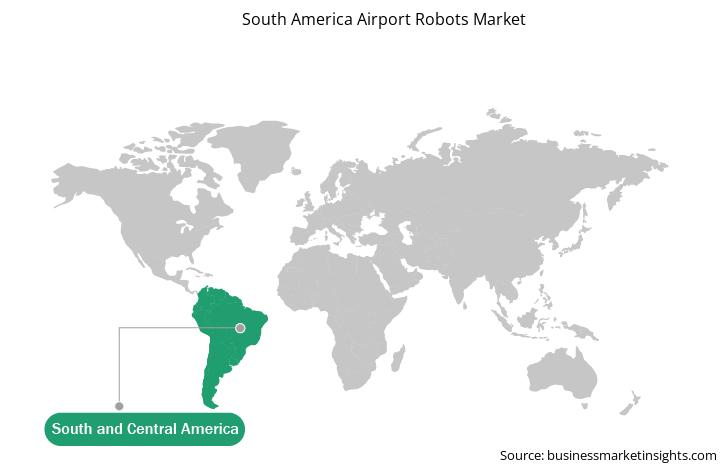The airport robots market in SAM segmented into Brazil, Argentina, and the Rest of SAM. Despite recent economic crises in countries such as Brazil and Venezuela, the overall business outlook of South American countries is expected to improve in the coming years. The effect of the economic crisis slowed the region's GDP growth; however, with stable plans in place from various governments, as well as initiatives for industrialization and development, South American countries will soon have plenty of trading opportunities. Airport robots are gaining traction in South America as a result of increased air traffic due to surge in tourism and trade. The rapid growth of air traffic in Brazil, as well as in other South American countries, is underlining the need of airport expansion. According to the CAF, proposals are currently underway to manage 3.9 million passengers in Uruguay's airport traffic by 2040. The Uruguay government is investing significantly in the construction of airports, with over 220 projects and a few “greenfield” projects planned for new tracks, new terminals, and capacity upgrades for the platform, flight field, charging terminal, and passenger terminal. These factors are likely to fuel the South American airport robots market during the forecast period. Increase in demand for advanced robots and construction of new airports and exigency for robust airport security are the major factor driving the growth of the SAM airport robots market.
In case of COVID-19, Brazil is the worst impacted country due to the coronavirus outbreak. As of April 2021, the country was still facing significant surge in COVID-19 cases. Apart from Brazil, countries such as Peru, Argentina, Uruguay, and Venezuela were also impacted by the pandemic and are still facing significant impact of the second wave of the pandemic. Countries such as Brazil and Argentina were under lockdown, and some parts of the region are still under lockdown, halting the business operation and manufacturing process. In some parts of the region, there are travelling restrictions, and various airport projects are also delayed. This has led to substantially low demand for various new machines and equipment that are used for operating the airport including robots. Further, manufacturers are also facing challenges in relation to procuring raw material and managing supply chain and logistics.

Strategic insights for the South America Airport Robots provides data-driven analysis of the industry landscape, including current trends, key players, and regional nuances. These insights offer actionable recommendations, enabling readers to differentiate themselves from competitors by identifying untapped segments or developing unique value propositions. Leveraging data analytics, these insights help industry players anticipate the market shifts, whether investors, manufacturers, or other stakeholders. A future-oriented perspective is essential, helping stakeholders anticipate market shifts and position themselves for long-term success in this dynamic region. Ultimately, effective strategic insights empower readers to make informed decisions that drive profitability and achieve their business objectives within the market.

| Report Attribute | Details |
|---|---|
| Market size in 2021 | US$ 25.42 Million |
| Market Size by 2028 | US$ 90.02 Million |
| Global CAGR (2021 - 2028) | 19.8% |
| Historical Data | 2019-2020 |
| Forecast period | 2022-2028 |
| Segments Covered |
By Application
|
| Regions and Countries Covered | South and Central America
|
| Market leaders and key company profiles |
The geographic scope of the South America Airport Robots refers to the specific areas in which a business operates and competes. Understanding local distinctions, such as diverse consumer preferences (e.g., demand for specific plug types or battery backup durations), varying economic conditions, and regulatory environments, is crucial for tailoring strategies to specific markets. Businesses can expand their reach by identifying underserved areas or adapting their offerings to meet local demands. A clear market focus allows for more effective resource allocation, targeted marketing campaigns, and better positioning against local competitors, ultimately driving growth in those targeted areas.

The SAM airport robots market is expected to grow from US$ 25.42 million in 2021 to US$ 90.02 million by 2028; it is estimated to grow at a CAGR of 19.8% from 2021 to 2028. Developing countries have become a hub of opportunities for various markets, including SAM airport robots market. Government authorities in these countries are planning and investing huge amount in the advancement of technologies to improve the overall infrastructure. Transportation and logistics activities are huge contributors to the development of any country, and therefore, developing countries are extensively focusing on enhancing and improving their transportation and logistics infrastructure, including air, road, and sea transport. Airways is an important mode of transportation; hence, governments of developing countries have planned development and revamping of various mid-size and large airports. Developing countries such as Chile and Argentina are expanding and revamping airports. As a part of expansion and revamping strategy, these airports would also be passing tenders on acquiring technologically advanced equipment including robots for ensuring convenience and providing superior experience to passengers. Hence, the SAM airport robot market players have huge opportunities to offer best-in-class, and highly reliable and cost-efficient robots for such new airport projects.
In terms of application, the terminal segment accounted for the largest share of the SAM airport robots market in 2020. In terms of terminal, the airport security and cleaning segment held a larger market share of the SAM airport robots market in 2020.
A few major primary and secondary sources referred to for preparing this report on the SAM airport robots market are company websites, annual reports, financial reports, national government documents, and statistical database, among others. Major companies listed in the report are ABB Ltd., Avidbots Corp., LG Electronics, SITA, and SoftBank Robotics.
The South America Airport Robots Market is valued at US$ 25.42 Million in 2021, it is projected to reach US$ 90.02 Million by 2028.
As per our report South America Airport Robots Market, the market size is valued at US$ 25.42 Million in 2021, projecting it to reach US$ 90.02 Million by 2028. This translates to a CAGR of approximately 19.8% during the forecast period.
The South America Airport Robots Market report typically cover these key segments-
The historic period, base year, and forecast period can vary slightly depending on the specific market research report. However, for the South America Airport Robots Market report:
The South America Airport Robots Market is populated by several key players, each contributing to its growth and innovation. Some of the major players include:
The South America Airport Robots Market report is valuable for diverse stakeholders, including:
Essentially, anyone involved in or considering involvement in the South America Airport Robots Market value chain can benefit from the information contained in a comprehensive market report.